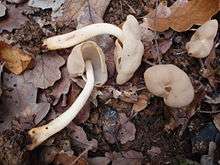Helvella elastica
Helvella elastica, commonly known as the flexible Helvella,[1] or the elastic saddle,[2] is a species of fungi in the family Helvellaceae of the order Pezizales. It is found in Asia, Europe, and North America. It has a roughly saddle-shaped yellow-brown cap atop a whitish stipe, and grows on soil in woods. Another colloquial name is the brown elfin saddle.[3]
| Helvella elastica | |
|---|---|
 | |
| Scientific classification | |
| Kingdom: | Fungi |
| Division: | Ascomycota |
| Class: | Pezizomycetes |
| Order: | Pezizales |
| Family: | Helvellaceae |
| Genus: | Helvella |
| Species: | H. elastica |
| Binomial name | |
| Helvella elastica Bull. (1785) | |
| Synonyms | |
| |
| Helvella elastica | |
|---|---|
float | |
| smooth hymenium | |
| cap is convex | |
| hymenium attachment is not applicable | |
| stipe is bare | |
| spore print is white | |
| ecology is mycorrhizal | |
| edibility: not recommended | |
Description
The fruit body of the fungus is grayish or olive-brown, saddle- or mitral-shaped (i.e., resembling a double mitre) and is attached only to the top of the stipe; it may be up to 3 centimetres (1.2 in) wide. The stipe is white, solid or filled with loosely stuffed hyphae, has a smooth surface, and is up to 8 centimetres (3.1 in) long by 1 centimetre (0.4 in) thick.[1] The flesh of H. elastica is brittle and thin. The odor and taste of this mushroom are not distinctive.[4]
Microscopic characteristics
The spores are oblong to elliptical in shape, translucent (hyaline), contain one central oil drop (guttulate), and have dimensions of 18–22 by 10–14 µm; young spores have coarse surface warts, while older ones are smooth. The spore-bearing cells, the asci, are 260 by 17–19 µm. The paraphyses (sterile cells interspersed between the asci) are club-shaped, filled with oil drops, sometimes branched, and are 6–10 µm at the apex.[1]
Edibility
Consumption of this fungus is not recommended as similar species in the family Helvellaceae contain the toxin gyromitrin.[5]
Habitat and distribution
This fungus is typically found fruiting singly, scattered, or clustered together on the ground or on wood in coniferous and deciduous woods.[6] It has been found in Europe,[4] North America (in "western states and provinces"),[7] Japan,[8] and China.[9]
Similar species
The closely related fungus Helvella albipes has a thicker stipe and a two- to four-lobed cap.[1] Another similar species, H. latispora, has cap edges that are curled upward, rather than inward as in H. elastica.[10]
Fibrinolytic activity
A 2005 Korean study investigated the ability of extracts from 67 different mushroom species to perform fibrinolysis, the process of breaking down blood clots caused by the protein fibrin. H. elastica was one of seven species that had this ability; the activity of the extract was 60% of that of plasmin, the positive control used in the experiment.[11]
References
- Tylutki EE (1979). Mushrooms of Idaho and the Pacific Northwest. Moscow, Idaho: University Press of Idaho. p. 76. ISBN 0-89301-062-6.
- Phillips R. "Rogers Mushrooms | Mushroom Pictures & Mushroom Reference". Archived from the original on 2008-11-21. Retrieved 2009-05-06.
- Arora D. (1986). Mushrooms Demystified: A Comprehensive Guide to the Fleshy Fungi. Berkeley, California: Ten Speed Press. p. 813. ISBN 0-89815-169-4.
- Jordan M. (2004). The Encyclopedia of Fungi of Britain and Europe. London, UK: Frances Lincoln. p. 52. ISBN 0-7112-2379-3.
- Horgen PA, Ammirati JF, Traquair JA (1985). Poisonous Mushrooms of the Northern United States and Canada. Minneapolis, Minnesota: University of Minnesota Press. p. 259. ISBN 0-8166-1407-5.
- McKnight VB, McKnight KH (1987). A Field Guide to Mushrooms, North America. Boston, Massachusetts: Houghton Mifflin. p. 45. ISBN 0-395-91090-0.
- Orr, Dorothy B; Orr RT (1979). Mushrooms of Western North America. Berkeley, California: University of California Press. p. 30. ISBN 0-520-03656-5.
- Nagao H. (2002). "Fungal flora in Chiba Pref., central Japan (III) Ascomycetes: Plectomycetes and Discomycetes". Journal of the Natural History Museum and Institute Chiba (in Japanese). 5: 111–32.
- Zhuang WY (2004). "Preliminary survey of the Helvellaceae from Xinjiang, China". Mycotaxon. 90 (1): 35–42.
- Kuo M. (August 2012). "Helvella elastica". MushroomExpert.com. Retrieved 2014-01-03.
- Kim JH, Yoo KH, Seok SJ, Kim YS (2005). "Screening of fibrinolytic activities of extracts from wild mushrooms collected in Mt. Chilgap of Korea" (PDF). Korean Journal of Mycology. 33 (1): 18–21. doi:10.4489/KJM.2005.33.1.018.